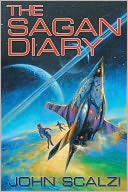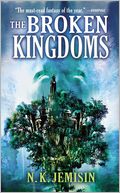The Broken Kingdoms and The Sagan Diary

The book begins with a preface from Lieutenant Gretchen Schafer, an analyst involved in reviewing and transcribing BrainPal memories from Special Forces soldiers like Sagan. Written as a letter of protest, Schafer complains that “what we have to work with are data-poor bits in which Lt. Sagan thinks about what appears to be a romantic partner of some sort…” She describes the files as “of some anthropological interest … but for our purposes these files are near useless.”
I read this as a nicely-done warning to the reader: this is not Old Man’s War. This is not action-heavy space battles and supersoldiers. It’s the musings and philosophizing and reflections of a soldier. A rather loving character study. It’s almost poetic at times:
I am not Death. I am killing; I am the verb. I am the action, I am the performance. I am the movement that cuts the spine; I am the mass which pulps the brain. I am the headsnap ejecting consciousness into the air.
I am not Death but she follows close behind…
It’s a fairly quick read, and an interesting change from the other things I’ve read by Scalzi. I definitely recommend reading his Old Man’s War books for context.
#

I liked Jemisin’s first book a lot, but it’s been almost two years since I read it, and unfortunately my memory of the details from that first book were a little fuzzy, because my brain leaks. The Broken Kingdoms works as a standalone, but I think I would have gotten even more out of it if I had the first story clear and fresh in my brain.
This is set ten years after The Hundred Thousand Kingdoms. From the back cover:
In the city of Shadow, beneath the World Tree, alleyways shimmer with magic and godlings live hidden among mortalkind. Oree Shoth, a blind artist, takes in a strange homeless man on an impulse. This act of kindness engulfs Oree in a nightmarish conspiracy. Someone, somehow, is murdering godlings … and Oree’s guest is at the heart of it.
Oree is a fascinating character. While blind to the mundane world, she can see magic, and can perform magic of her own through her paintings and drawings. She is not a typical fantasy warrior or kick-ass heroine. Like all of Jemisin’s characters, she feels very real, with her own struggles and desires, her own history and scars.
Heartfelt. That’s the word I’ve been struggling with as I work on this review. Jemisin’s writing feels heartfelt. She understands and loves this world, these characters, and it shows.
Shiny, the homeless man who refuses to speak, was particularly interesting. He appears mortal most of the time, but is unable to die (permanently, at least – think of a glowing Jack Harkness), and manifests powerful magic when protecting Oree. He’s arrogant and rude, but even before you learn his backstory, you can tell he’s also lost in the world.
Lil is another great character, a godling who is both disturbing and fun. (I just realized why I like her. At one point she unselfconsiously devours the bodies of the dead, because that’s just what she is. She’s like a superpowerful version of my goblins with scary-big teeth.)
Storywise, it was fascinating to see some of the fallout from the events of the first book, and to learn more about the history of the gods and the godlings. There’s a fair amount of action as Oree struggles against enemies with the power to kill godlings … perhaps even to kill the gods themselves. It gets pretty dark and intense for a while toward the end, but the ending works. A story of mortals warring against themselves and the gods isn’t the newest idea in fantasy, but ideas are easy. It’s the execution – the thoughtfulness, the characterization, the history – that make this book work.
I’m having a hard time talking about the book in more detail without spoiling things. So I’ll just say this is the second of Jemisin’s books I’ve read, and I’m looking forward to picking up her third.






Leslie
March 27, 2012 @ 9:47 am
I always enjoy your reviews (except that they inevitably make my “to-be-read” list longer). I’m not so much into the hard science fiction, but I really love the passage you’ve quoted from the Scalzi book, so perhaps I’ll give it a try. Expanding horizons are good, yes?
I’ve had Jemisin on my list for awhile, but haven’t gotten around to reading any of hers yet. Of course, I also have a leaky brain, so maybe I’ll wait until the third one comes out and I can read them all at once. 🙂
Jim C. Hines
March 27, 2012 @ 11:03 am
I believe Jemisin’s third book came out in October of last year, actually…